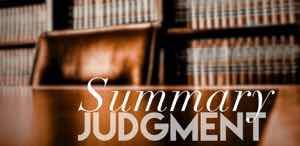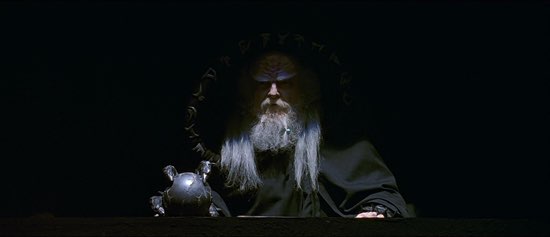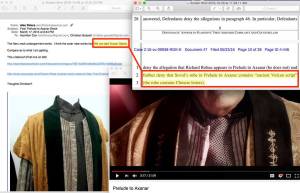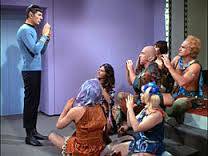Judge Denies Axanar Its Fair Use Defense
Table of Contents
See also: Fact Check: Axanar's Chances on Appeal and Axanar Assures Donors Lawyers Will Stay for Appeal
While a Federal judge denied summary judgment January 4, 2017, to both sides in the Axanar copyright infringement lawsuit, he dealt a major blow to the defendants’ hope to use fair use as a defense in the case.
Going to Trial
The 15-page decision moved the case forward to its scheduled January 31 trial date, striking out a central part of the defendants’ case. While Klausner found Axanar was indeed substantially similar to Star Trek using an extrinsic test, despite the defense’s protestations to the contrary, he left to the jury the intrinsic, or subjective, decision over whether the “total concept and feel of [Axanar and Star Trek works were] substantially similar.”1)

'Objectively Infringing'
The extrinsic test Klausner used examines “specific expressive elements: the plot, themes, dialogue, mood, setting, pace, characters, and sequence of events in the two works to determine if articulable similarities exist.“2)
Here, Klausner wrote, the “Defendants [producer Alec Peters and Axanar Productions] intentionally use elements from the Star Trek Copyrighted Works to create works that stay true to Star Trek canon down to excruciating details. Defendants even touted that ‘Axanar feels like Star Trek.'”3)
« Defendants intentionally use elements from the Star Trek Copyrighted Works to create works that stay true to Star Trek canon down to excruciating details. » — Judge R. Gary Klausner
Willful Infringement
While Klausner found it likely Peters indeed infringed on Star Trek’s copyrights, he decided to leave it to a jury to determine whether Peters willfully infringed — whether what he thought he was doing was all right. The jury’s decision makes a difference only in the extent of Peters liability — how much he might have to pay in damages.
For that, Peters had relied on a long history of Star Trek fan films unhindered by copyright disputes. And even though Peters repeatedly stated Axanar was not to be called a fan film, his lawyer, Erin Ranahan asserted the claim was made only to distinguish Axanar’s quality from other fan works. Klausner held that state of mind is something the jury must examine in order to determine whether his infringement was willful.4)

Peters Personally Profited
The judge also found that Peters indeed personally profited from Axanar, and that if the jury ultimately finds Axanar and Star Trek are substantially similar in total concept, Peters would be liable for personally contributing to copyright infringement and vicariously infringing by personally profiting. The judge found:
Peters’ substantial involvement in, such as writing script for, the Axanar Works materially contributes to the infringing conduct of Axanar Productions. … As to vicarious infringement, Peters, as the president of Axanar Productions, was in charge of and was responsible for its conducts. He was responsible for many of the artistic decisions. He supervised and controlled Axanar Productions. Peters also profited directly from the Axanar Works.5) [citations omitted]
Peters' Reply to Judge's Ruling

Peters issued the following statement on his surrogate's blog following the judge’s order:
This morning, Judge Klausner made a ruling that the case will go to jury trial to determine if Axanar is “substantially similar” to the CBS copyrighted works. If it is, then the jury will have to find if the infringement is “willful” or “non-willful”, and Judge Klausner already stated that “Peters’ actions demonstrate a respect for Plaintiffs’ intellectual property that makes a finding of willfulness on summary judgement inappropriate.” If the jury does not find “substantial similarity” then the case will be dismissed.
Depending on the outcome of the trial, Axanar may choose to appeal the verdict to the Ninth Circuit, where Erin Ranahan is 5-0. The Ninth Circuit Court of Appeals is also known to favor artist rights. So the story of Axanar continues…
AxaMonitor assesses Axanar's chances on appeal »
Not Premature
Ranahan had repeatedly argued CBS and Paramount had no case for copyright infringement because Axanar had yet to be produced, existing insubstantially as a series of ever-changing screenplay drafts.
Judge Klausner was not persuaded by Axanar attorney Erin Ranahan’s use of Wikipedia.
Klausner had found that line of argument unpersuasive when Ranahan first made it in the dismissal motion he rejected in May 2016; he found it even less persuasive when having to deal with it yet again in her motion for summary judgment:
The Court explained its rejection of this argument in the order denying Defendants’ Motion to Dismiss.. … The Court will not repeat its rationale here, except to note that evidence of a final shooting script satisfies the judicial standard for summary judgment.6)
Copyrightable Elements
The defense had long argued that many of the items CBS and Paramount had claimed were protected by copyright were actually in the public domain or so vaguely drawn as to not merit protection. Included in that claim were the Star Trek aliens Vulcans and Klingons, and even the lead Axanar character himself, Garth of Izar.
Klingons and Vulcans
The judge rejected those arguments with regard to Star Trek’s most prominent alien species:
Klingons are a militaristic, alien species from the planet Qo’noS. They are long-time enemies of the Federation. Klingons have distinctive physical features including ridged foreheads, dark hair and skin, and upward sloping eyebrows. Klingon men have facial hair.
Vulcans are a part of the Federation, a species that suppresses emotions in favor of logic and reason. They are advanced technologically. Vulcans have pointed ears and upswept eyebrows. Vulcan men usually have a bowl-shaped haircut. Taken together, these characteristics of Klingons and Vulcans are not “elements of expression[s] that necessarily follow from the idea” behind the expressions (visual expressions, for example) and may be entitled to copyright protection.7)
Garth of Izar
And with regard to Garth, Klausner applied the same three-part test to determine his copyrightability: That the character must demonstrate both physical and conceptual qualities; that he be sufficiently recognizable as the same character whenever he appears, and that he be especially distinctive with some unique elements of expression:
Since Garth has appeared as a live character, he has physical as well as conceptual qualities. As stated above, Garth was a former starship captain and was famous among Starfleet officers for his exploits in the Battle of Axanar. In fact, his exploits were required reading at the Starfleet Academy. He charted more planets than any other Starfleet captain. In the episode, Garth discussed his victory in the Battle of Axanar with Captain Kirk, the Captain of U.S.S. Enterprise. In addition, a 2003 novel, titled Garth of Izar and copyrighted by Paramount, further developed the character. Garth’s identity as a Federation hero sufficiently delineates him and sets him apart from a stock spaceship officer.8)
Why Fair Use Was Denied
The central part of the defense case was the idea that Axanar’s approach to Star Trek was to transform it, to give it new meaning because of the way Peters and his team portrayed a Star Trek story.
That notion of transformativeness lies at the heart of fair use, a provision of U.S. copyright law stating that certain uses of others’ intellectual property should be allowed because of the public interest in its examination, scholarship or criticism (including the idea of parody).
« The Axanar Works are not transformative. … The Axanar Works are commercial. » — Judge R. Gary Klausner
Fair Use Analysis
The law provides for a four-part test for a court to determine whether any given use of copyrighted material is fair. Those four parts are:
- Purpose and character of the infringing use.
- Nature of the copyrighted work.
- Amount and substantiality of the portion used.
- Effect of the use upon the potential market.
Klausner found CBS and Paramount prevailed on all four counts.
Purpose and Character
Klausner examined whether Axanar was intended as a nonprofit or commercial work, and whether its use of Star Trek was transformative.
Commercial Nature of Axanar
The judge found Axanar was plainly commercial, despite the fact Peters made his videos available for free on the Internet:
It is undisputed that Peters hoped to derive non-monetary benefits, for example, other job opportunities, from the Axanar Works. Defendants profit from exploitation of the copyrighted material without paying the customary price. The Axanar Works are commercial.9)
Peter’s attorneys made a big point of claiming that Axanar was making no profit, but the judge found that even the indirect benefits Axanar realized from its infringing activities were sufficient to call the production commercial:
Common experience suggests that [the defendants] stood to gain at least indirect commercial benefit from the [viewership] boost which [they] had reason to hope would (and in fact did) result from the Axanar Works. … The successful fundraising campaign leveraging the popularity of Prelude is an example of such indirect benefit.10)
'Not Transformative'
The judge also plainly declared, “The Axanar Works [Prelude to Axanar and Axanar] are not transformative,”11) a designation key to what Axanar’s attorney had argued made Peters’ use of Star Trek elements fair use under U.S. copyright law.
Mocks the Mockumentary
Ranahan’s argument for transformativeness hinged on Prelude‘s presentation as a fictional documentary (“mockumentary”) set within the Star Trek universe, further relying on Wikipedia to assert that such a format was inherently a form of parody.
Klausner was not persuaded by Ranahan’s use of Wikipedia:
The threshold question when fair use is raised in defense of parody is whether a parodic character may reasonably be perceived. Here, the Court has difficulty discerning from the Axanar Works any criticism of the Star Trek Copyrighted Works. This is not surprising since Defendants set out to create films that stay faithful to the Star Trek canon and appeal to Star Trek fans.12)
Nature of the Copyrighted Work
The judge found the creativity of Star Trek as expressed in 13 movies and six television series “have transported the hearts of a legion of fans to the Star Trek universe. … They are the type of works that are given broad copyright protections.”13)
Amount Used of the Copyrighted Work
Peters had long claimed that his use of Star Trek was minimal, far less than that used by fan films generally. The judge found this argument unavailing:
Copying is not excused merely because it is insubstantial with respect to the infringing work. As Judge Learned Hand cogently remarked, “No plagiarist can excuse the wrong by showing how much of his work he did not pirate.”14) [emphasis added]
Potential Market Harm
Peters’ attorneys spent many pages in their briefs alleging Axanar had caused no past economic harm to Star Trek and that its activities posed no future harm, particularly since Axanar only promoted the Star Trek franchise and would be distributed for free, thereby not competing with the studios for consumer dollars.
Klausner dismissed this line of reasoning as well:
This factor requires courts to consider not only the extent of market harm caused by the particular actions of the alleged infringer, but also whether unrestricted and widespread conduct of the sort engaged in by the defendant would result in a substantially adverse impact of market substitution for the original and for derivative works.15)
The judge found Prelude was exactly the kind of derivative work to which copyright holders hold exclusive ownership, pointing to a CBS-owned Garth of Izar novel and role-playing game depicting the Battle of Axanar.16)
Market Substitute
Klausner also rejected Axanar’s claim of no past harm because Prelude wasn’t a finished work itself, but a promotional work intended to raise nearly $2 million for the never-produced Axanar feature:
Prelude in that sense cannot be a market substitute of Star Trek television series or motion pictures, just as a trailer does not substitute for a feature-length film. The Axanar Motion Picture has not yet been made or released and its script is not yet released. Hence it cannot have any market impact. On the other hand, Defendants have successfully raised over a million dollars from Star Trek fans at Defendants’ prompting of funding the Axanar projects instead of “dumping hundreds or thousands of dollars a year on . . . cable channels” on which the Star Trek Copyrighted Works are shown. … He wanted to create “a whole new way that fans can get the content they want, by funding it themselves.”17)
Klausner concluded that unrestricted and widespread conduct like that of Axanar would hurt the market for Star Trek:
The fact that Defendants distributed Prelude and the Vulcan Scene for free online and intend to likewise distribute their future works may likely increase the risk of market substitution as fans choose free content over paid features.18)
Trek References in Judge's Order
As he did in his May order denying the defense’s motion to dismiss the case, Klausner snuck several Star Trek references into his ruling:
Like many other Star Trek fans, Peters wants to make his own Star Trek production. However, going where no man has gone before in producing Star Trek fan films, Defendants sought to make “a professional production,” “with a fully professional crew, many of whom have worked on Star Trek itself,” and raised over a million dollars on crowdsourcing websites Kickstarter and Indiegogo to fund their projects.19)
Also:
There is no dispute that Plaintiffs have ownership of caopyrights to the Star Trek Copyrighted Works, and that Defendants have access to these Works. Thus, the copyright infringement claim can live long and prosper if the Axanar Works are substantially similar to the Star Trek Copyrighted Works.20)
And:
Peters “was interested in creating alternative ways for fans to view Star Trek” – the way to Eden perhaps.21)
Also, from the episode, “A Taste of Armageddon”:
Sometimes a feeling is all we humans have to go on. But for substantial similarity, the law demands more. 22)

Keywords



